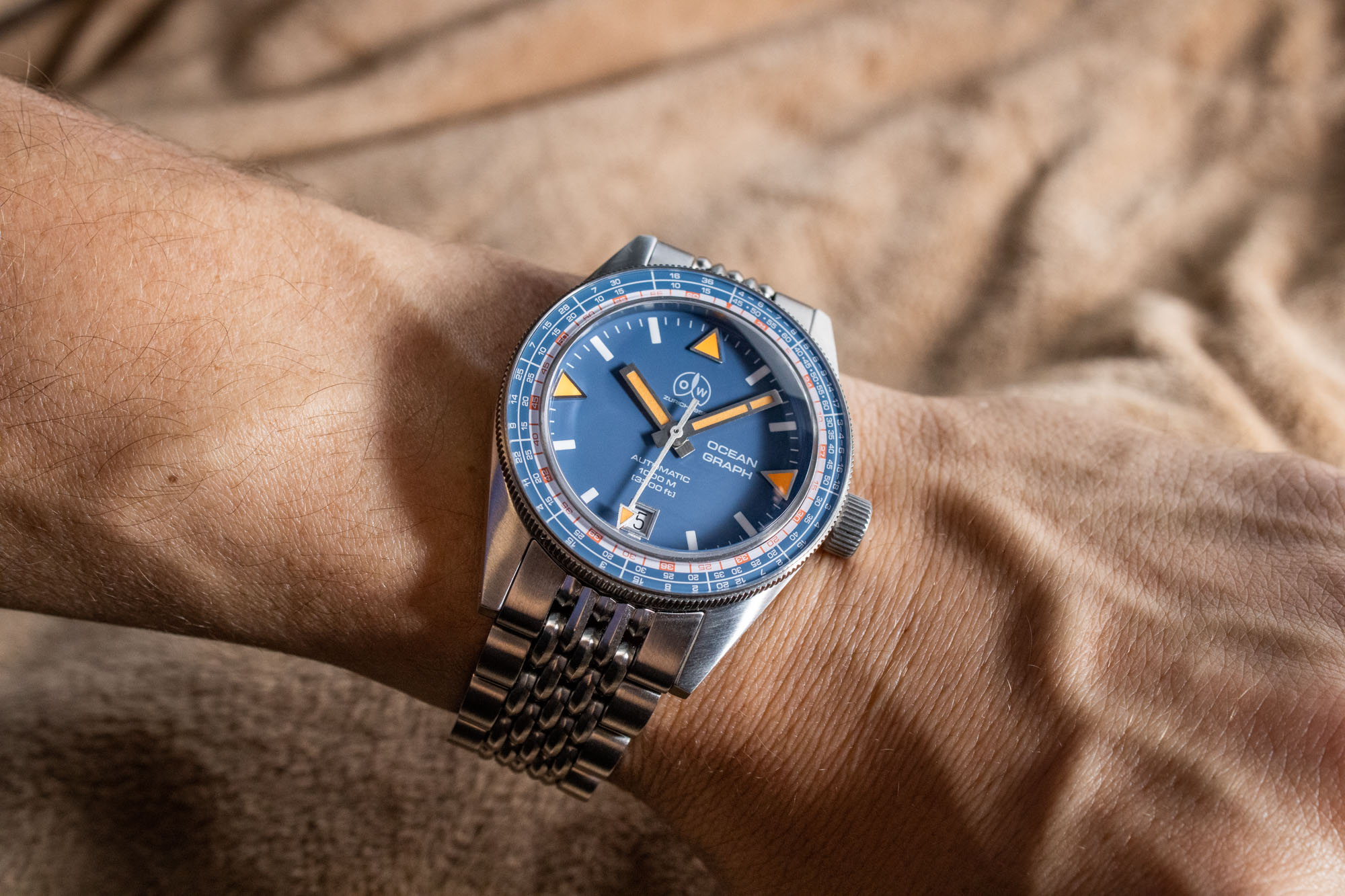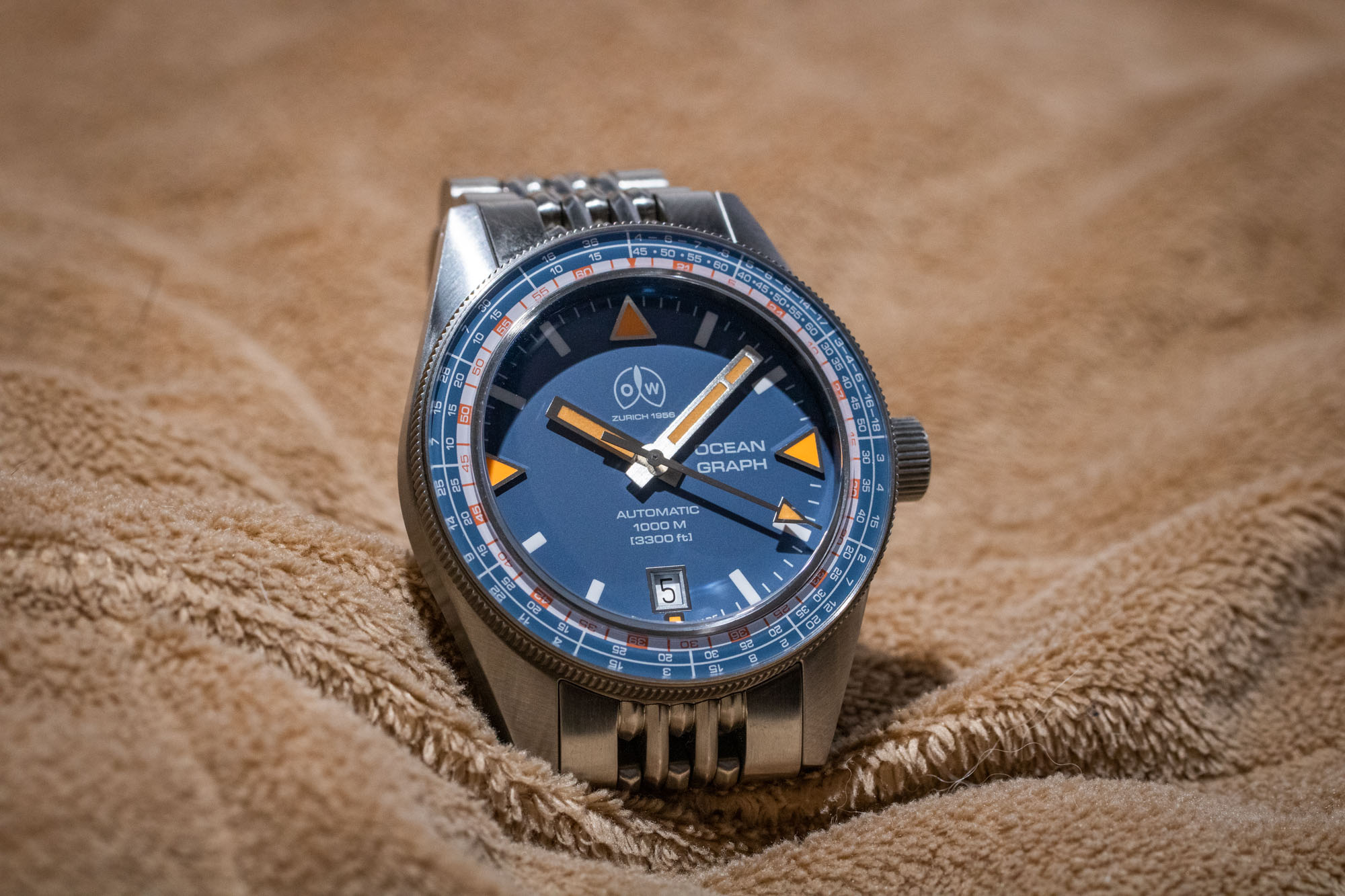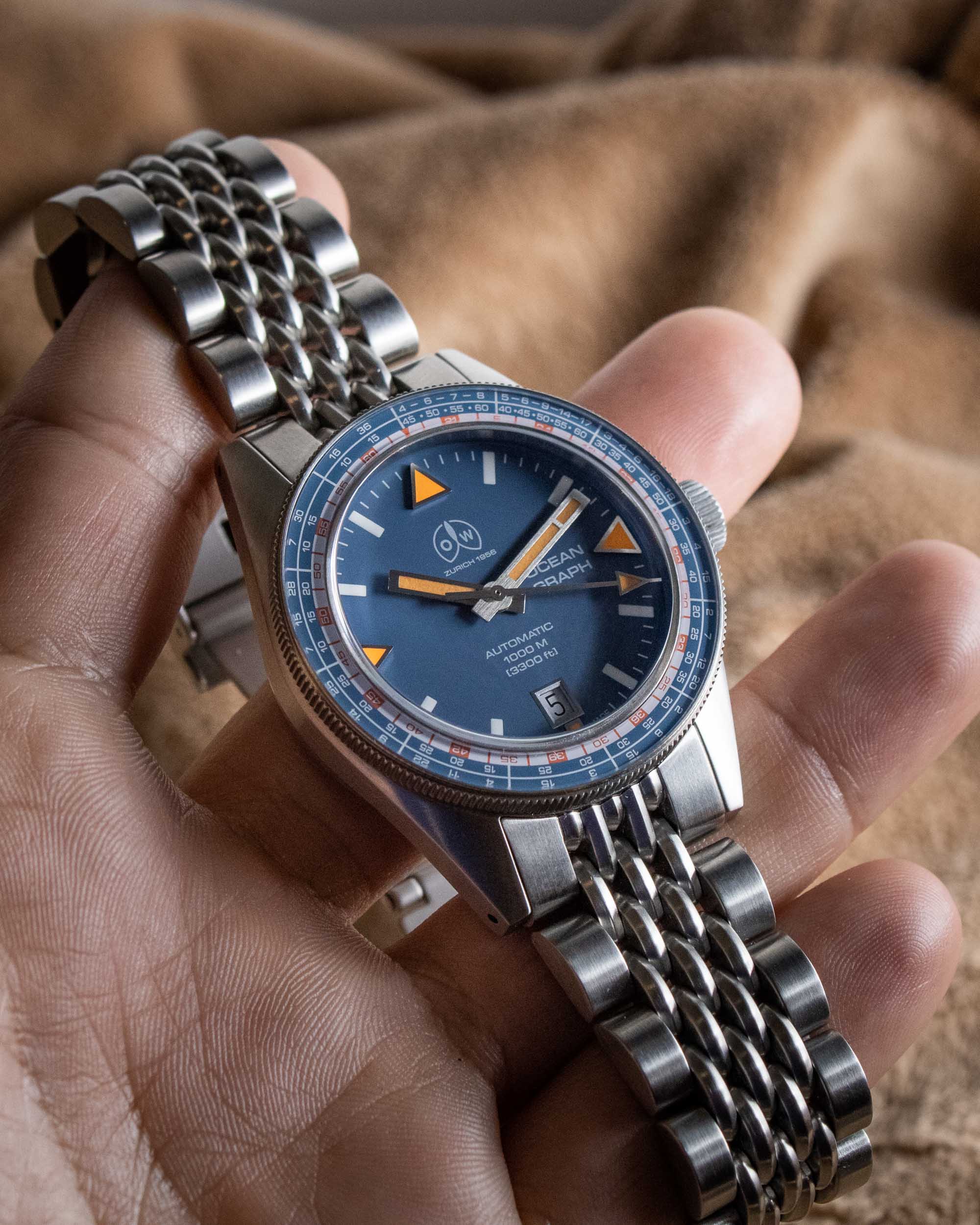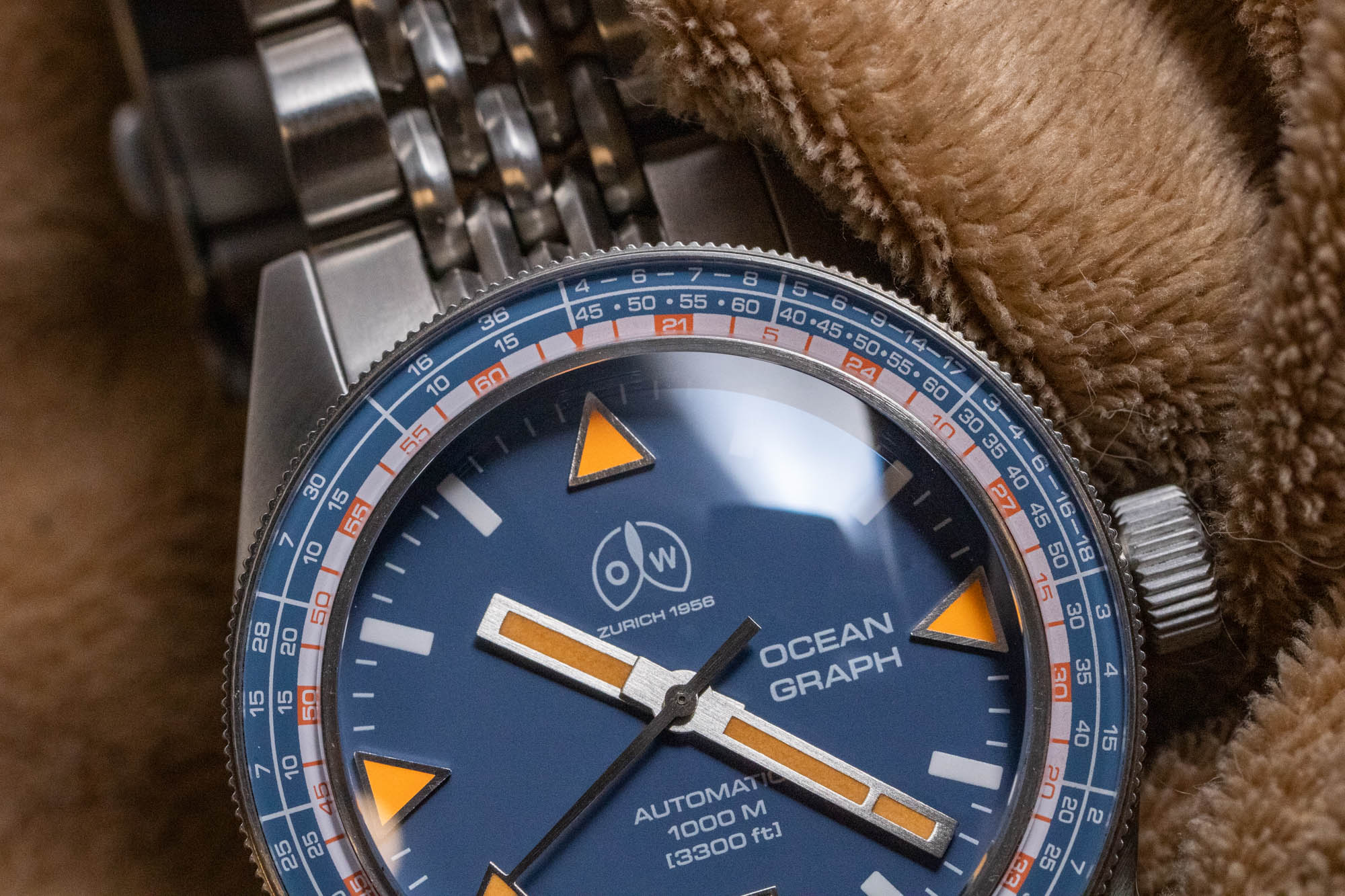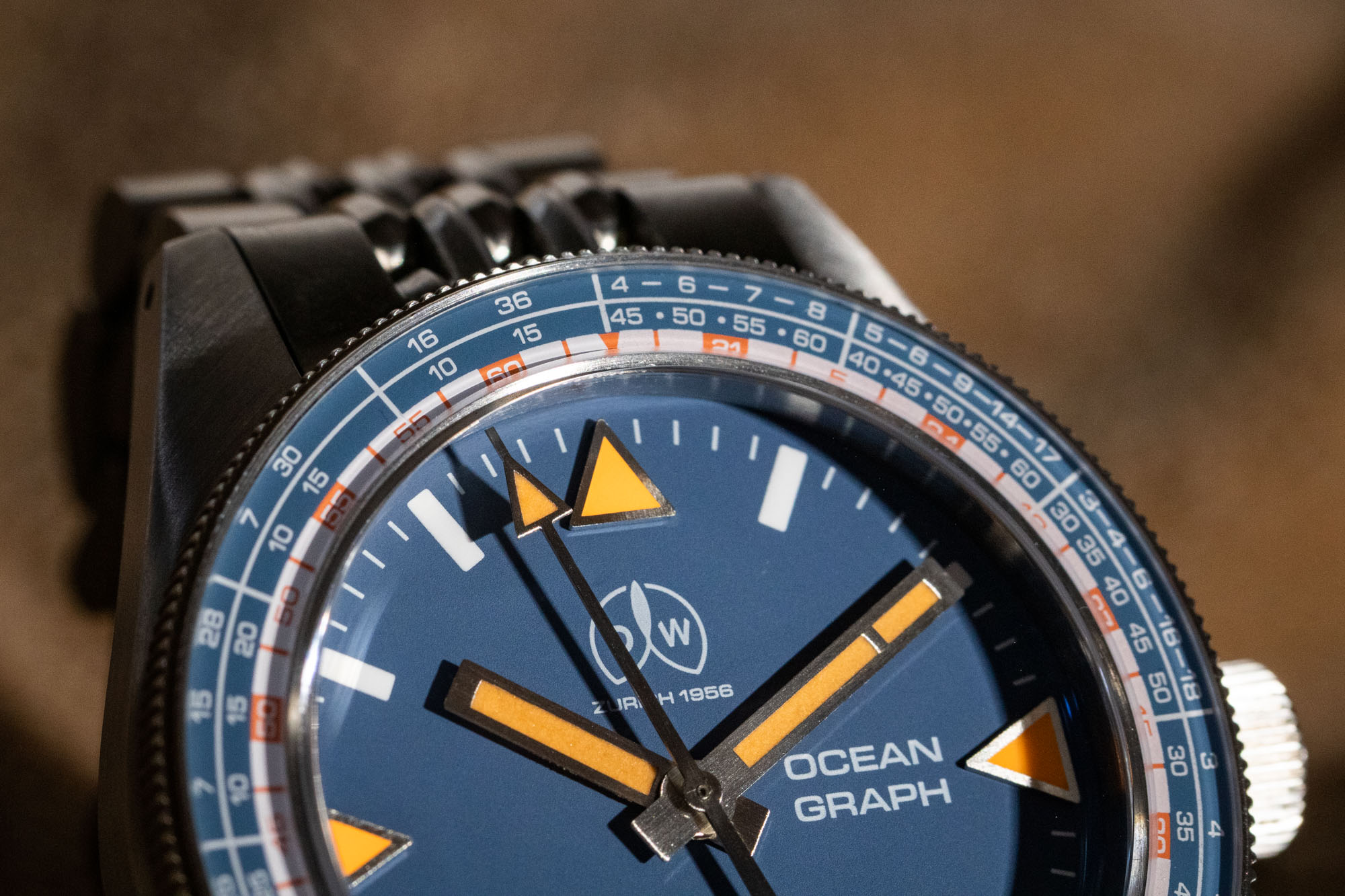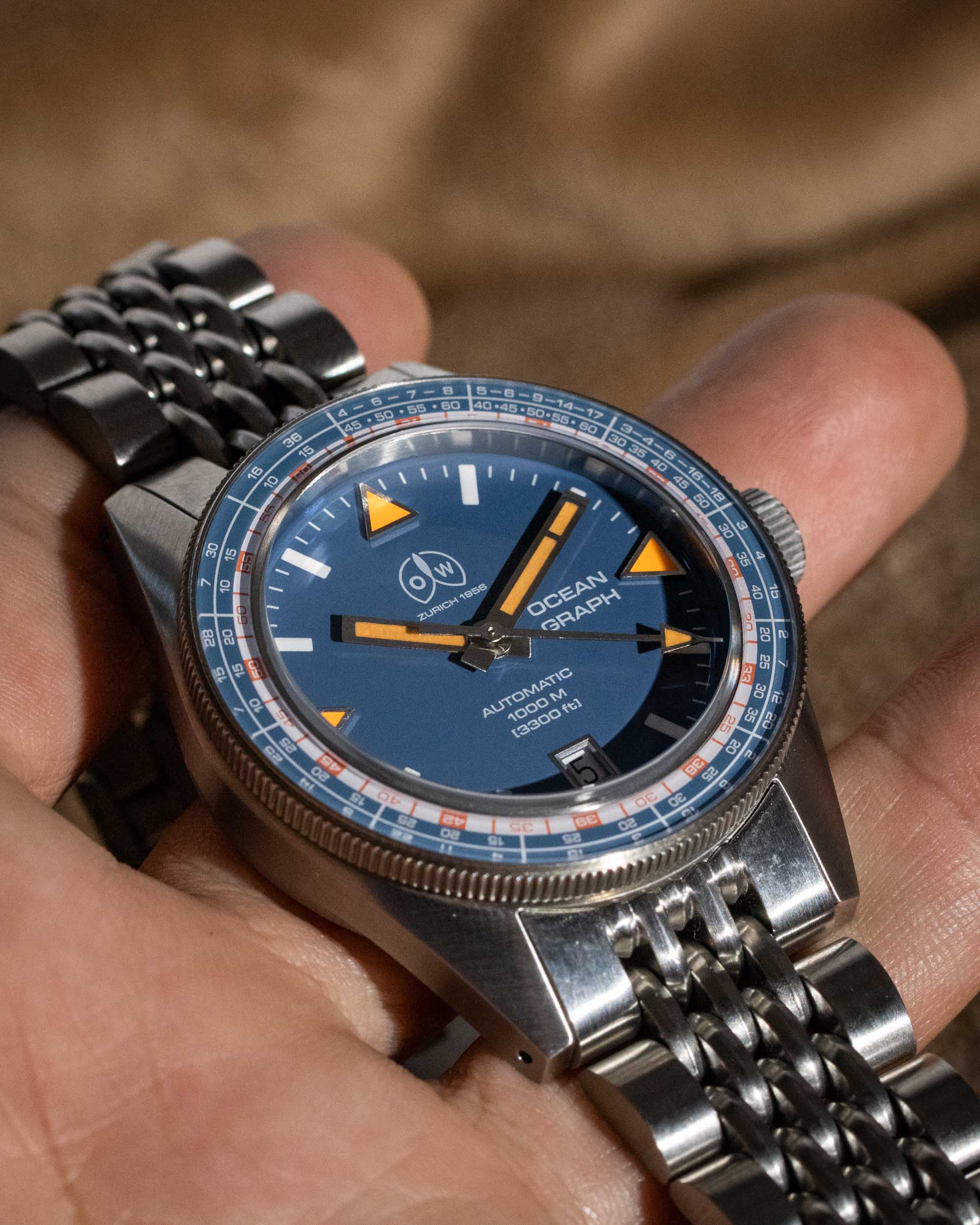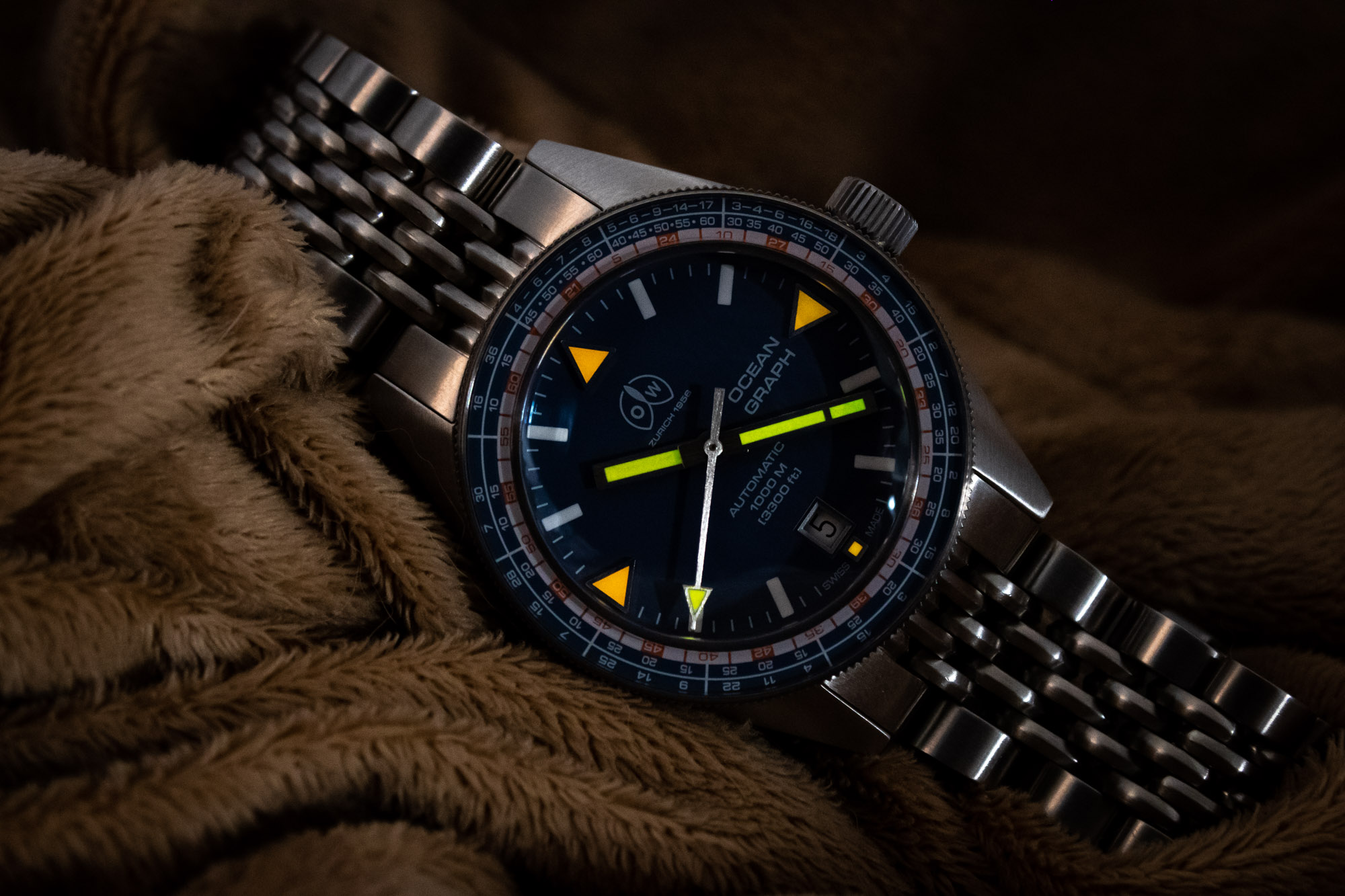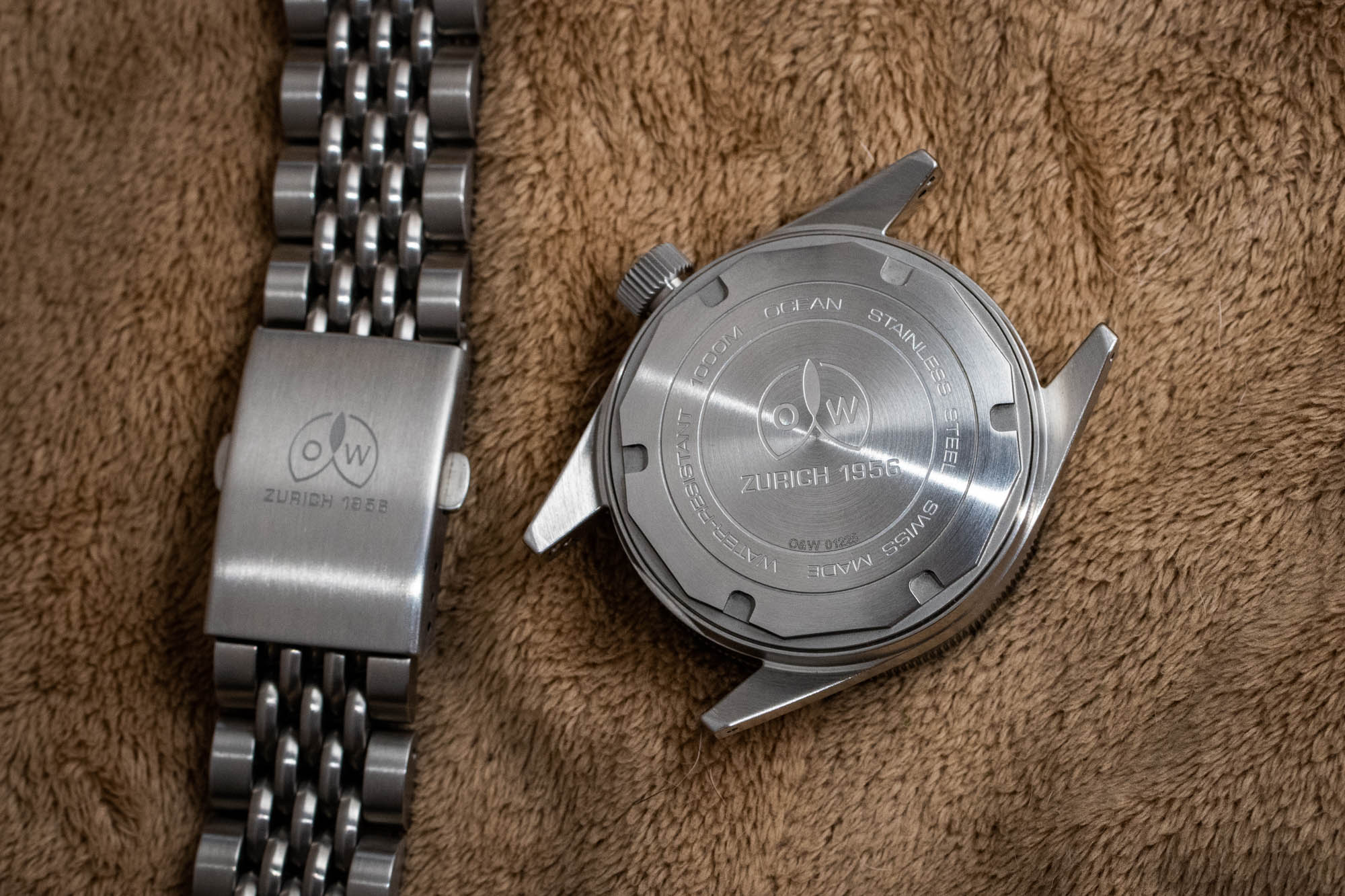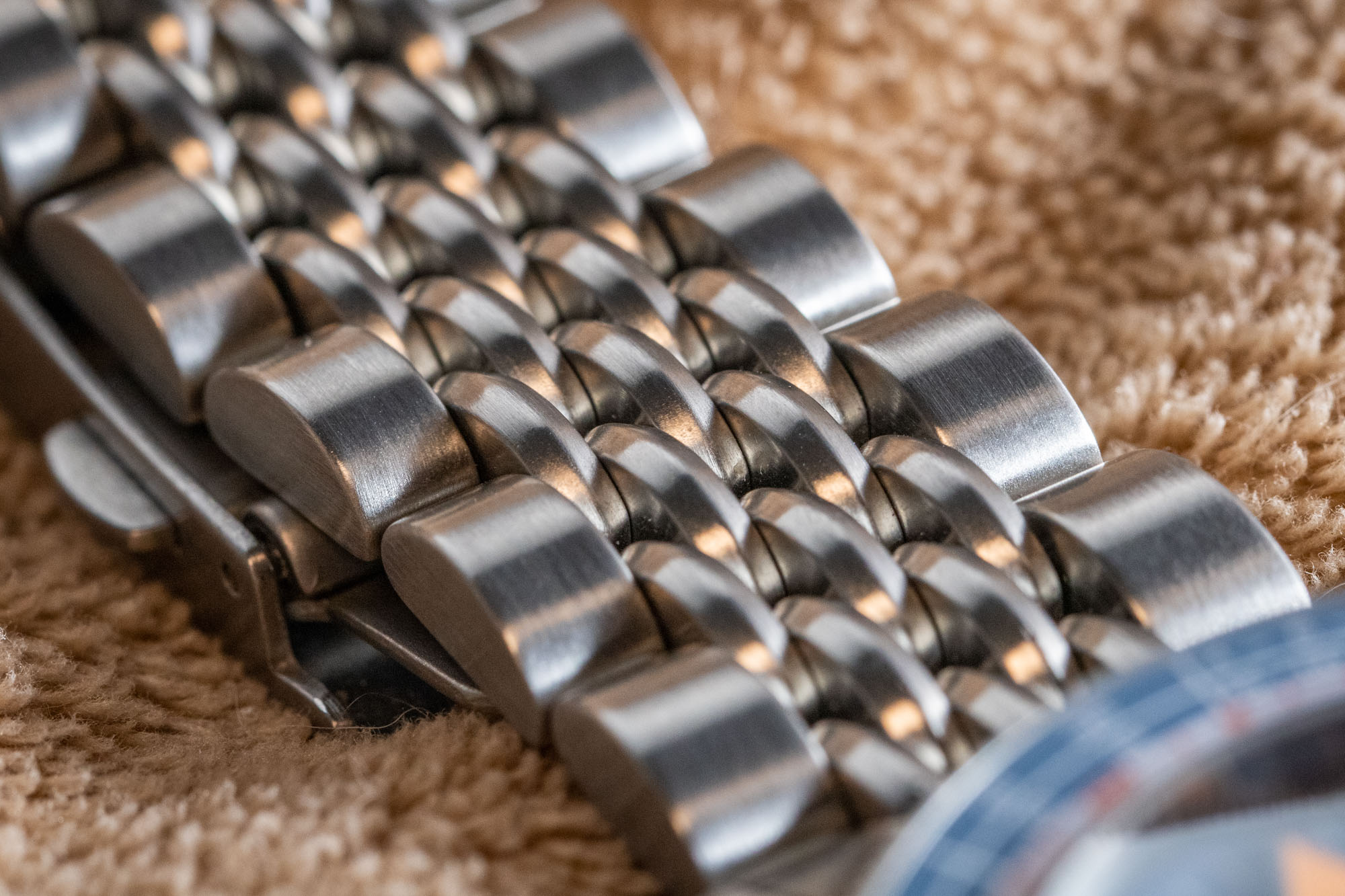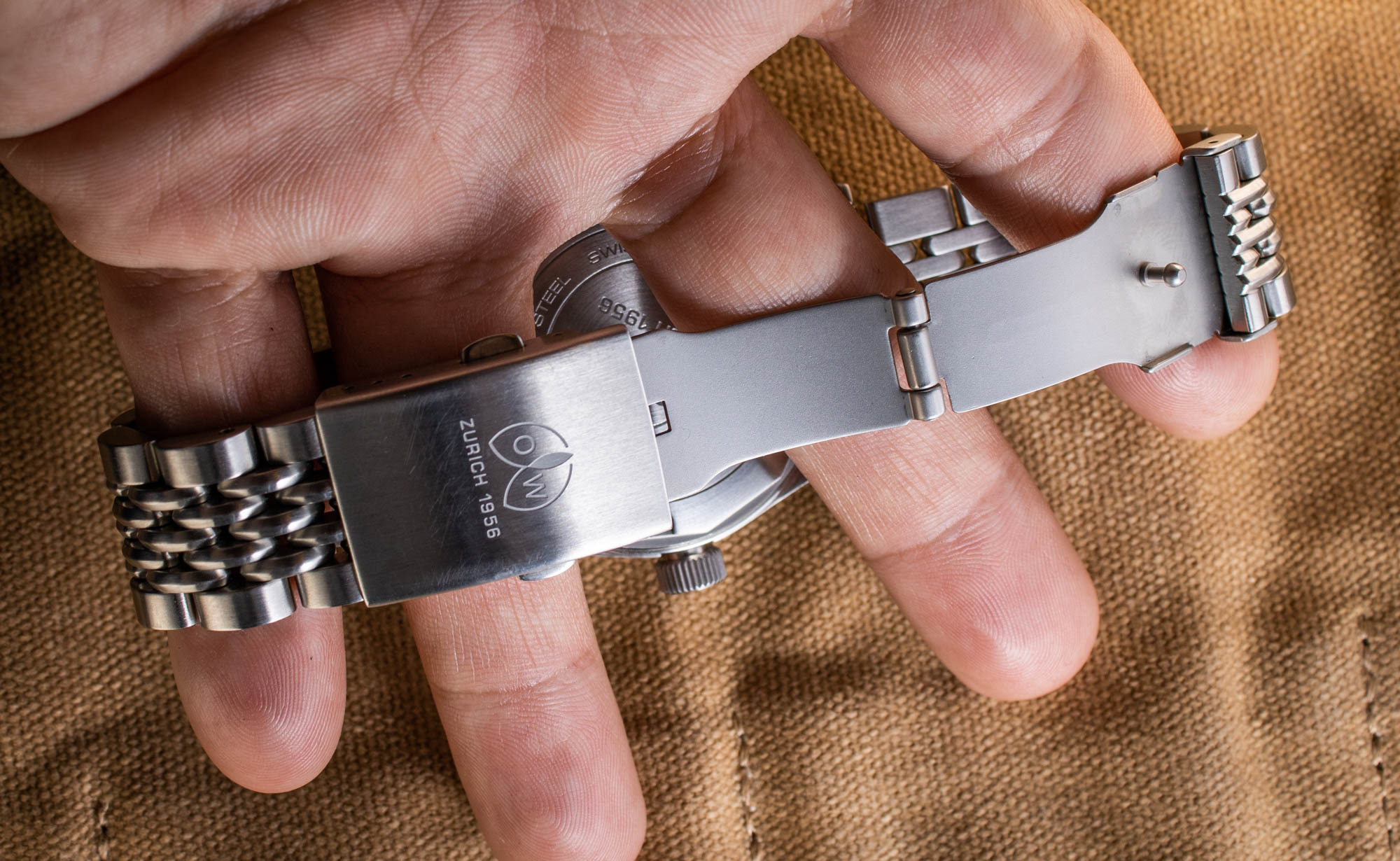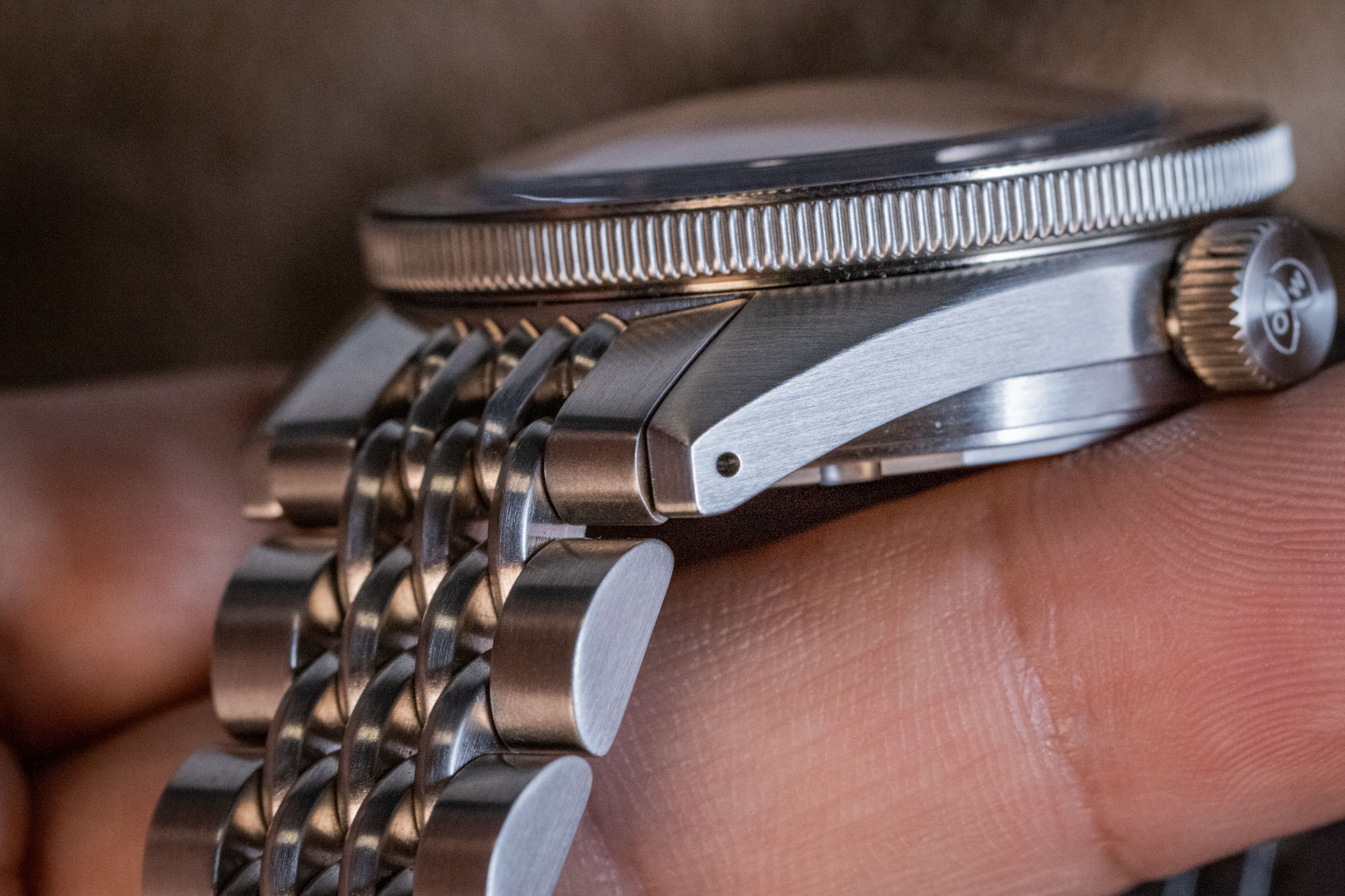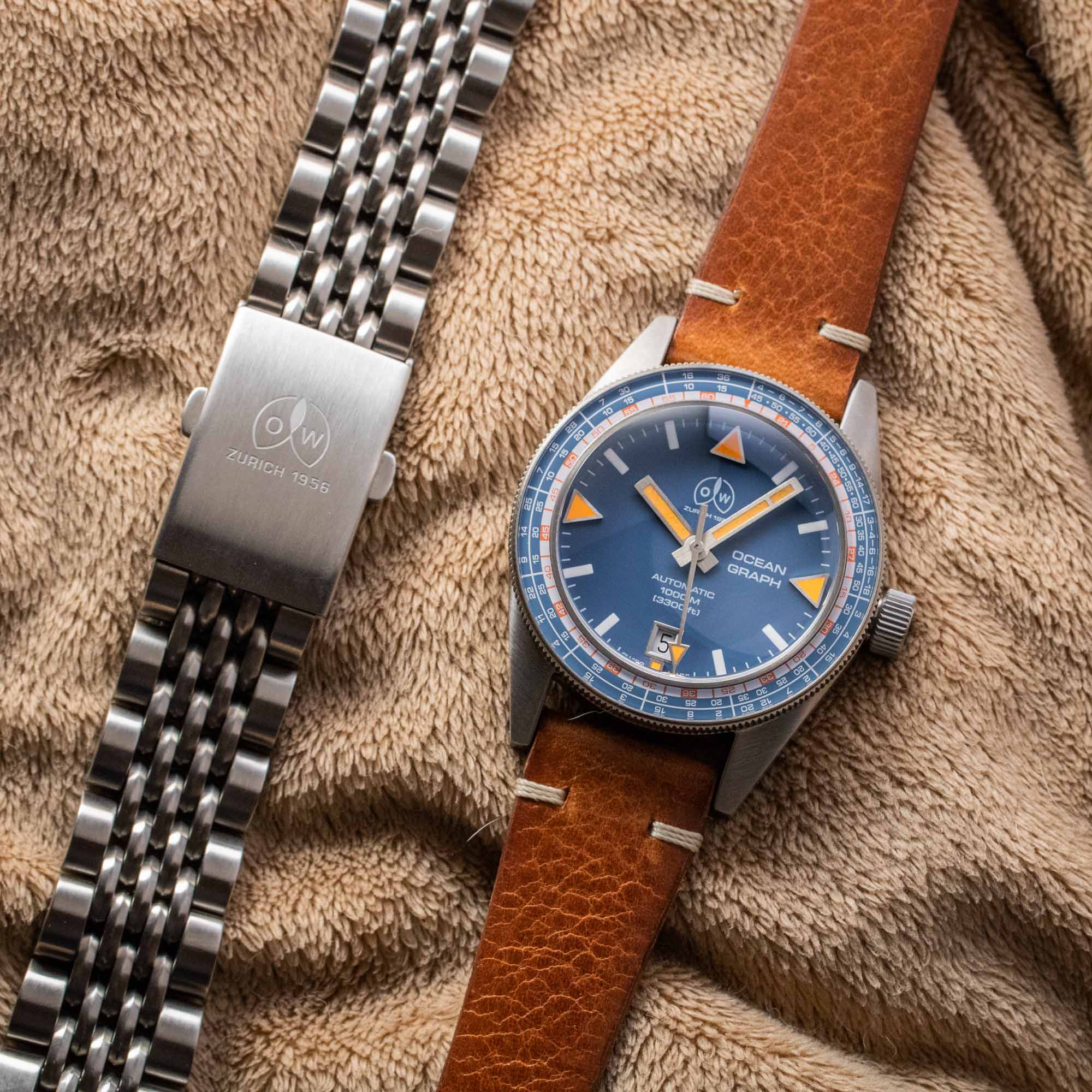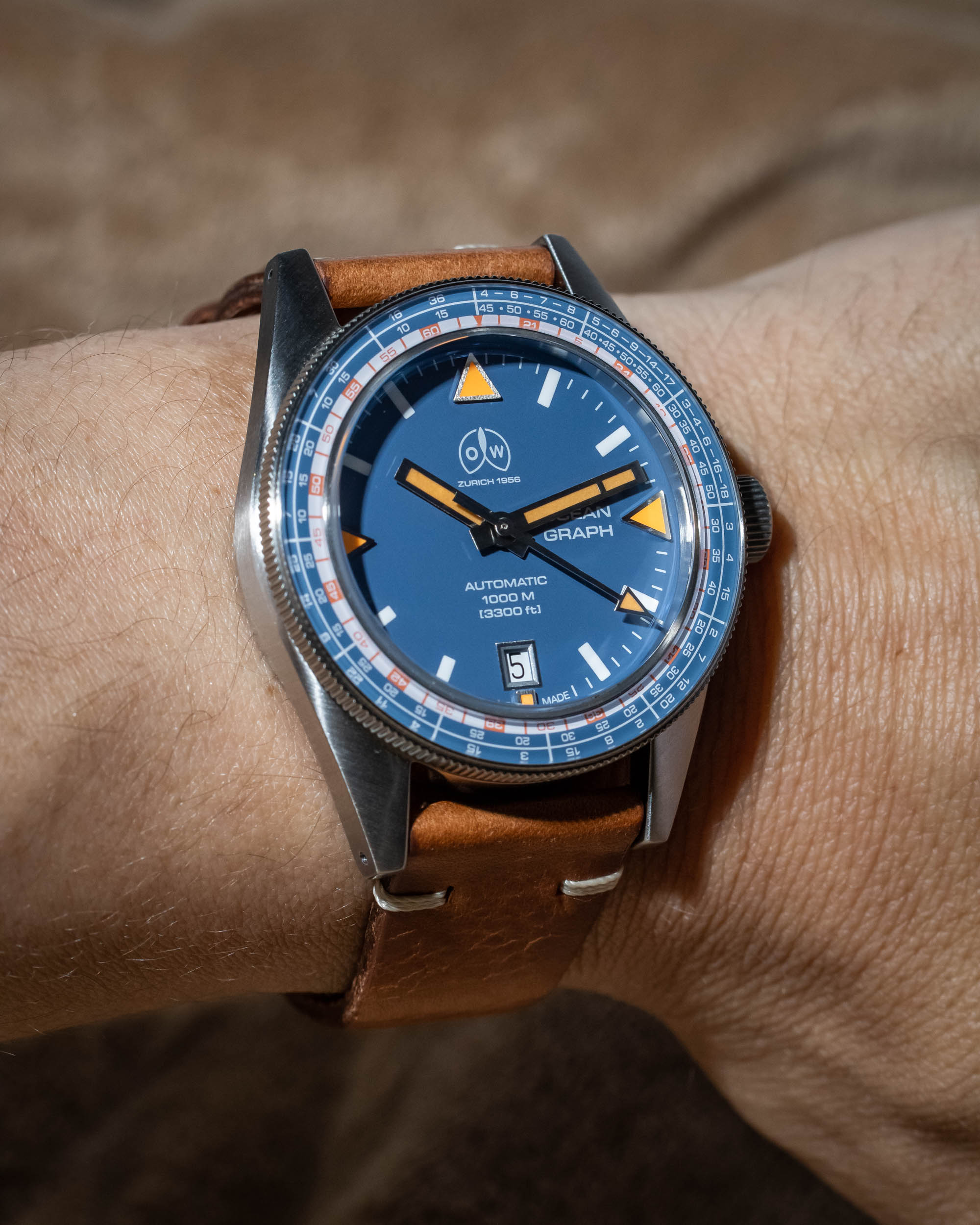Hands-On: Ollech & Wajs Ocean Graph Watch
Although Ollech & Wajs was originally founded in 1956 and has enjoyed a cult following among vintage collectors and enthusiasts for a number of years, the brand was relaunched in 2017 and has since been building out its modern revitalized collection. Ollech & Wajs originally built its reputation during the pre-quartz era by producing highly capable sport and tool watches, and this same emphasis on durability and function-forward timepieces remains one of the defining characteristics of the Swiss brand to this day.
Like many companies operating within the sports watch space during the 1960s, Ollech & Wajs fully embraced the public’s rising interest in scuba diving, and the brand produced a number of high-performing dive watches that were worn by everyone from explorers and scientists to astronauts and military personnel. The modern Ollech & Wajs brand still places a heavy emphasis on underwater timepieces, and the Ollech & Wajs Ocean Graph is a vintage-inspired diver that not only pays tribute to the original “Ocean-Graph” diver from 1968, but also all of the other purpose-built aquatic timepieces that made up the brand’s widely respected “Precision” line of tool watches.
The modern Ollech & Wajs Ocean Graph offers a heavily vintage-inspired overall aesthetic, and rather than being an exact recreation of a specific model from the brand’s archives, it simply features a retro overall appearance and the decompression bezel from the original Ocean-Graph diver from 1968. That said, the modern Ollech & Wajs Ocean Graph features the same core case design that can be found on a number of the brand’s other modern models, and it is entirely manufactured in Jura, Switzerland. Crafted from 316L stainless steel, the case of the Ocean Graph measures 39.56mm in diameter by 49.5mm lug-to-lug, and it offers a thoroughly vintage-inspired profile with long angled lugs and no type of crown guards whatsoever.
While the overall case shape is very similar to that of a traditional 1960s skin diver, the Ollech & Wajs Ocean Graph is significantly more capable than most watches that offer this same general aesthetic, and it feels very well constructed, despite being fairly utilitarian in its overall design. At the 3 o’clock location is an oversized screw-down winding crown that is signed with the brand’s logo and features a system of four internal gaskets for maximum resistance to moisture intrusion. The reverse side of the case gets fitted with a solid stainless steel screw-down caseback, while the dial side is protected by a 5.6mm thick domed sapphire crystal that offers an inherently vintage overall aesthetic while also helping provide the watch with a whopping 1,000 meters of water resistance (which actually gets tested to 1,200 meters).
Due to the significant dome of the crystal, the overall thickness of the Ollech & Wajs Ocean Graph comes in at 15.8mm, and the lack of curve to the lugs does little to mitigate its perceived height. Although the lugs don’t exactly hug the wrist, they do feature two sets of springbar holes, which allows for a wider variety of straps, and also enables users to position the strap in a manner so that the watch sits better on their wrist. Additionally, while the set of springbar holes near the tip of the lugs is drilled, the secondary set closer to the case is not, and in my opinion, this seems to be the most practical approach when it comes to pure functionality. Two sets of drilled holes would have inevitably looked awkward, and having one of the sets drilled means that shoulderless spring bars can be used, for those who prefer to wear their watch on pass-through style straps without the worry of the strap catching on the shoulder of the springbar and causing it to come free from the case.
Surrounding the heavily domed sapphire crystal is a 120-click unidirectional rotating bezel with a coin-edge style rim. The bezel turns fairly easily and offers a satisfying action with virtually no perceptible backplay whatsoever. However, rather than having a standard 60-minute elapsed time scale like a normal dive watch, the bezel is fitted with a blue and orange multi-function decompression scale that is printed on the bottom side of a crystal insert. Given that the brand’s website does not explicitly state that the insert is made from sapphire, I can only assume that it is made from some type of mineral glass, as most companies would explicitly list a sapphire insert as a selling point, similar to how they consistently do with their watch crystals.
The decompression scale itself consists of three segmented concentric rings with the innermost one being an orange and white 60-minute timing scale with additional indications for the maximum depth of the dive (represented in meters). The two surrounding scales appear in blue and white, with the middle one indicating the dive times for which decompression will be necessary (according to the corresponding depth indicated by the orange central scale), while the outermost scale on the insert indicates the decompression times (represented in minutes), which are calculated according to the depth and total duration of the dive. Given that most people who wear dive watches don’t actually use them for scuba diving, pretty much everything except the 60-minute elapsed timing scale will be more-or-less useless above the surface of the water, although it is ultimately this unique decompression scale bezel on the modern Ocean Graph that connects it to its vintage predecessor with the hyphenated version of its name.
While the decompression scale bezel on the Ollech & Wajs Ocean Graph undeniably offers quite a lot of information, the printing is rather small in order to cram everything on a fairly thin insert, and at-a glance legibility is absolutely terrible. On top of that, none of the bezel markings are luminous, meaning that what little legibility does exist virtually disappears entirely in low-light conditions, and I can’t imagine anyone actually trying to use the bezel in any real capacity while scuba diving, except in the absolute most desperate of situations. The zero marker for the bezel (which is a tiny inverted triangle on the orange innermost scale) is so small that it takes a few seconds to even locate, so you might as well forget about quickly aligning it with the minute hand while doing something else that requires your attention, such as driving a car or even walking in a crowded street. For all intents and purposes, the bezel is essentially just a nice-looking fidget-spinner, with no real practical applications beyond being a fun and aesthetically-intriguing conversation starter.
The dial of the Ollech & Wajs Ocean Graph features a matte blue surface with white printed text, applied markers at the cardinal points, and a rectangular date window at the six o’clock location. The triangular markers at the 3, 9, and 12 o’clock positions, plus the small square below the date window at 6 o’clock, all feature a brushed finish on their metallic surrounds and are filled with bright orange Super-LumiNova, with even the metallic frame for the date aperture receiving a matching brushed top surface. At the center of the dial are a trio of hands with a brushed finish and orange Super-LumiNova inserts, with the hour and minute hand appearing as wide batons and the seconds hand as a slightly tapered shaft with a prominent triangular luminous tip.
Although all of the lume is a bright orange color in the daylight, only the hour markers glow orange in the dark, and the orange-colored lume on the three hands actually all glows green. While the different colors of lume are certainly fun and help add contrast in dark conditions, only the hour markers for the cardinal points actually glow at all, which further supports my statement that the Ocean Graph is far from ideal for any real tool-worthy scuba diving applications (despite its massive levels of water resistance). Furthermore, to even reach a fraction of its incredible 1,000-meter depth rating, saturation diving would almost inevitably be a required part of the process, and it’s important to note that the Ollech & Wajs Ocean Graph does not feature a helium escape valve at all. While I highly doubt anyone will really miss the lack of an HEV on the side of the case, it does seem to be a bit of a curious omission given the downright excessive water resistance offered by the modern Ocean Graph. That said, I personally appreciate this approach, as a helium escape valve is just one more potential point for water ingress with zero actual practical uses, unless you are one of the very few individuals who is either a saturation diver or otherwise works in a highly pressurized chamber.
Powering the Ollech & Wajs Ocean Graph is the tried and true ETA 2824-2 automatic movement, which is very much a known quantity and probably the single most commonly used Swiss-made mechanical caliber in the industry today. Running at a frequency of 28,800vph (4 Hz) with a power reserve of approximately 38 hours, Ollech & Wajs’ version of the ETA 2824-2 is known as the OW5P and it features a mainplate engraved with the brand’s name, along with a custom machined Ollech & Wajs oscillating weight. A familiar design that is known for its reliability, the ETA 2824-2 is a highly practical option for a robust diver like the Ocean Graph, and while it may not be the most interesting from either an aesthetic or horological perspective, it doesn’t need to be for a watch like this, especially since it remains hidden away behind a solid stainless steel caseback.
While the standard Ollech & Wajs Ocean Graph is fitted with a blue and white Perlon fabric strap, the version reviewed here is technically called the Ocean Graph S, as it comes with a matching stainless steel “beads of rice” bracelet fitted to its 20mm lugs. With completely solid links, single-sided screws, and machined end-links, the bracelet for the Ocean Graph feels quite well-made, and it features an entirely brushed finish that helps give it a slightly more utilitarian aesthetic compared to most other beads of rice bracelets. Additionally, the three rows of smaller center links all feature a slight ridge running down their top surfaces, which further helps provide the Ocean Graph bracelet with more of a rugged overall design compared to the smooth and rounded shapes of the center links that typically exist on this style of bracelet.
Although the bracelet itself feels quite solid and comfortable on the wrist, it isn’t exactly perfect. Operating with a double push-button release and signed with the Ollech & Wajs logo, the clasp is more than functional, but it does slightly feel a bit underbuilt compared to the bracelet and the case of the watch. Rather than being crafted from machined components, it is entirely made from stamped sheets of stainless steel, and it does not include any sort of integrated micro-adjustment system, beyond three sizing holes to place the springbar. The only advantage of this simple structure is that it ultimately makes for a small and thin clasp, which means that there is very little bulk on the underside of the wrist, along with minimal additional weight for what is already a rather chunky and hefty watch.
My only other minor gripe with the bracelet has to do with the end links, although I’m really not sure there is any actual solution to this issue, and I ultimately believe that Ollech & Wajs went with the lesser of two evils here. While the tips of the lugs are squared off at the ends, the end links have a rounded profile to correspond with the adjacent links of the bracelet, and it gives them the appearance of being slightly poor-fitting, despite actually fitting the case very nicely. With that in mind, had Ollech & Wajs squared off the end links, it would have completely thrown off the look of the bracelet itself, and it would have ultimately been of much greater detriment to the design, rather than just the appearance of the end-link being slightly too big for the case.
The two sets of springbar holes should be taken as an encouragement to play with different strap combinations, and while orange and blue may not be a colorway that goes with everything, the playful vintage vibes of the Ocean Graph enable it to exist as far more than just a dive watch. A quick strap change to something in the complete opposite direction in terms of aesthetics — in this case, a nice golden brown Hirsch Bagnore calfskin leather strap — and the Ollech & Wajs Ocean Graph looks absolutely nothing like a 1,000-meter diver, but rather something that you might see on someone’s wrist while leisurely getting coffee over the weekend. While trying to wear it as a proper dress watch may be a bit of a stretch, the Ocean Graph ultimately has far more aesthetic versatility than the vast majority of other timepieces that offer these outright excessive levels of water resistance.
All minor gripes aside, I actually like the Ollech & Wajs Ocean Graph quite a bit. While the bezel is more or less useless, so is 1,000 meters of water resistance; however, that is exactly what makes the Ocean Graph such a fun watch. Additionally, despite being something you could take to unfathomable depths, the Ocean Graph more-or-less looks like a colorful vintage skin diver with a funky bezel, and its reasonable case size ultimately creates a very easy-to-wear overall package. Ollech & Wajs states that over 90% of the watch is Swiss-made (excluding the strap and packaging), and except for its rather inauspicious clasp, the overall quality offered by the Ocean Graph seems entirely appropriate given its official retail price of 1,796 CHF (which converts to $1,937.85 USD, at the time of writing). Despite its impressive water resistance, I really see the modern Ocean Graph being worn by its owners most frequently as an incredibly fun vacation watch that offers all of the functionality of a serious overbuilt diver, without actually having the appearance of one. For more information on the Ollech & Wajs Ocean Graph, please visit the brand’s website.

